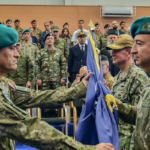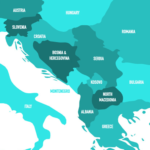Serious attempts to declare Kosovo’s independence date back to 1980, when the Kosovar Albanians launched a movement for the recognition of Kosovo as a separate republic within Yugoslavia, and then – for full-blown independence. During the breakup of the SFRY and after Kosovo’s accession to Serbia in 1992, ethnic Albanians have periodically raised the issue of independence. Finally, in 1996, the simmering conflict turned into an open civil war between the Kosovo Liberation Army and Albanian military units on one side and the Serb-Yugoslav forces on the other.
As a result of the war, in 1999, the territory of Kosovo came under the UN control, and on February 17, 2008, the parliament of Kosovo declared the territory’s independence, which was supported by over a hundred UN member states. Serbia has not recognized the independence of Kosovo, which is why the country has no final recognition around the world.
The majority of Kosovo’s population is Albanian, with the exception of a few communities that are predominantly Serb. Unrest among Kosovo Serbs often escalates the relations between Serbia and Kosovo.
The EU puts the issue of Serbia’s recognition of Kosovo on the path to membership, which both states seek.
A logical question arises: what are the reasons for the stagnation of the settlement process? In our opinion, among the many, the following should be singled out:
- The inability of Serbian public opinion to accept the reality that Kosovo will develop outside of Serbia. Kosovo is walking the path of independence, and this is not going to change ever. Unfortunately, most Serbian politicians believe that any move to recognize Kosovo’s independence will equal its political death. And perhaps, not only political one. And postponing the resolution of Serbia’s relations with Kosovo and the implementation of previously reached agreements in this context turns the problem into a classic frozen conflict;
- The reluctance of both Kosovo and Serbia to implement more than 30 bilateral deals, among which such important ones as the Brussels Agreement of 2013, the Washington Agreement of 2022, and this year’s Ohrid Agreement;
- Complicated relationship between Aleksandar Vučić and Albin Kurti as there is a deep personal mutual mistrust between the two leaders. This stems from their past as both started their political careers as radicals. Kurti devoted his whole life to the struggle for the independence of Kosovo, while Vučić still cannot give up the “Kosovo is Serbia” Vučić, and the idea of creating a “Greater Serbia” is not completely foreign to him, even today. And that is why the two leaders still cannot come to terms with each other;
- Contradictory and inconsistent policy of the West regarding the issue of normalization of Kosovo-Serbia relations and lack of close coordination between the countries. For example, there are five special representatives for the Western Balkans – representing the US, the UK, France, Germany, and the European Union. The latter is Miroslav Lajčak, Slovakia’s former Minister of Foreign Affairs, Slovakia is among the five EU member states that never recognized Kosovo’s independence (which also has a certain influence on settlement attempts with Lajčak’s participation). Each of these representatives sometimes plays their own game, which is understandable. After all, the focus is on the foreign policy of their respective country, without agreeing it with other colleagues. At the same time, accusations of aggravating the situation are being voiced against either Belgrade or Pristina;
- The Russian factor. The country was gradually relegated from participating in the resolution of the Kosovo-Serbian settlement. Therefore, it tries to block all steps aimed at reaching a consensus, sponsors political forces in Serbia that do not seek a solution to the problem, and organizes media campaigns against those in Serbian society who fight for a settlement. And to make matters worse, they promises the Serbian army support in the event of a “special operation” and draws joint plans with Serbia’s military leadership, apparently just in case a radical escalation occurs. Russia understands that the settlement of mutual territorial claims between Serbia and Kosovo will facilitate the accession of both countries to the EU, which will further reduce Russian influence in the region.
The second question is what are the possible future scenarios? At the same time, it is imperative for everyone to strengthen the contingent of KFOR stabilization forces in Kosovo, which has already begun.
The first scenario is the categorical refusal by Vučić and Kurti to implement any agreements. Kosovo refuses to form the Association of Serbian Communities, and Serbia increases its military presence on the border, again pushing the Kosovo Serbs to radical anti-government actions. In response come Western sanctions against both countries, farewell to European integration, and the introduction of a visa regime by the European Union. It is unlikely that the “Russian brothers” will rush to Serbia’s rescue: the budget is becoming thinner and the war in Ukraine prevents direct action. The collapse of the economy and political instability is coming, which only plays in Russia’s interests so it will continue to destabilize the situation. The EU and the US will continue to increase pressure on Serbia and Kosovo. The fragile balance between war and peace will prevail.
The second scenario is the stabilization of the situation, demilitarization of the border areas, and the start of the implementation of previous agreements under the control of the EU and the US. Serbia, in addition, joins Russia sanctions. Countries are given a full “green light” toward European integration. The main trend of the agreements is the long-standing proposal – not to recognize, but to coexist, following the example of the existence of East and West Germany before their unification in October 1990.
The third scenario (similar to the second) implies that early elections in Serbia bring victory to either Vučić or the opposition. The parties start implementing the agreements and sit down at the negotiating table again, and there is still the same option – not to recognize, but to coexist.
The fourth scenario (so far unlikely) is the intervention of the Serbian army and special services. History shows that the Serbian army repeatedly changed the course of Serbia’s history and even influenced the course of events on the continent, being involved in provoking the start of World War 1. However, we live in the XXI century, and a military coup in Europe is close to impossible. Theoretically. However, it is not necessary to completely rule out the intervention by the security forces, who will certainly be pushed toward the move by Russia.
Finally, the fifth scenario is the implementation of all agreements by both countries in a typical Balkan style — ever so slowly, without a haste. There will be many different excuses to not adopt important decisions – elections in one of the signatory countries, elections in the USA or the EU, or something of this kind. Negotiations on joining the European Union begin. And later everything will somehow calm down and resolve itself.



